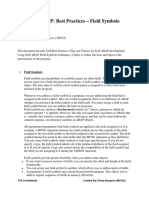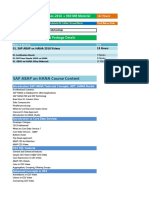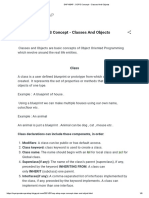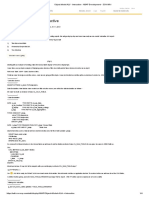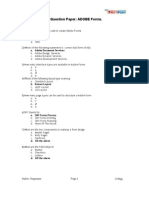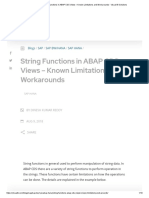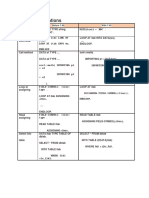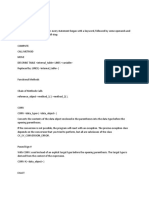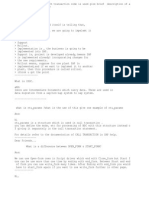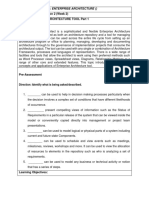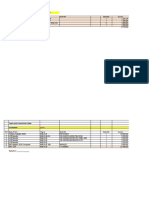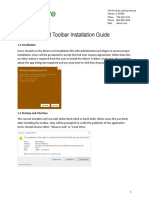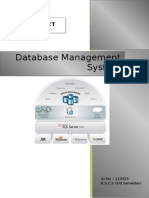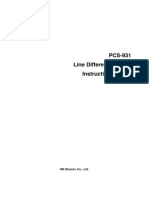ABAP NEW SYNTAX
AUTHOR: SUSHANT SINGH CHHATRYA (11066)
SAP BRF+ CONSULTANT
Purpose:
- To familiarize ABAP developers with the new syntax introduced in versions 7.4 and 7.5.
Scope:
- Covers the new syntax enhancements in ABAP versions 7.4 and 7.5
- Comparison with old syntax is provided in code.
Benefits:
- Empowers developers to leverage enhanced programming capabilities.
Notes:
- All programs are in the HET Server under the package name ZNEWSYNTAX.
- Please refrain from modifying existing code; instead, create your own test code.
JUNE 19, 2024
INVENIOLSI
SUSHANT SINGH 0
�Table of Contents
1. Introduction
2. New Features of OPEN SQL
3. Inline Declaration
4. COND as Replacement for IF
5. SWITCH as Replacement for CASE
6. String Expression || as Replacement for CONCATENATE
7. VALUE as Replacement for APPEND (BASE)
8. CORRESPONDING (Except/Mapping)
9. ALPHA(IN/OUT) as Replacement for Conversion FM
10. NEW
11. LET
12. CONV
13. REDUCE as Replacement for LOOP
14. FILTER
15. Table Expression as Replacement for READ TABLE
16. Join Improvements
Extra:
17. Control Break Statements
• at first
• at last
• at new field_name (Add on: SUM)
• at end of field_name
18. Database Operators
• Insert
• Update
• Delete
• Modify
19. Use of Field Symbol over Work Area
SUSHANT SINGH 1
�Introduction:
- BASIC:
Open SQL statements are a subset of Standard SQL that is fully integrated in ABAP.
Native SQL is a variant of SQL specific to the database system and is executed directly by
the database system.
1.
2.
- Data Objects: Variable, Internal tables, work area, select option (That hold the data)
SUSHANT SINGH 2
� - OLD
- NEW
- Checkout Program: ZNEWSYNTX_OPEN_SQL(HET Server)
3. CASE:
OLD Way:
- Fetch Data with Select Query:
- Fetched data:
SUSHANT SINGH 3
� - Looping over this table, and based on condition, fetching it over new table:
- Had to define 2 different structures as per requirement:
SUSHANT SINGH 4
� NEW Way:
Check Program: ZNEWSYNTX_OPEN_SQL_CASE (HET Server)
4.
SUSHANT SINGH 5
�NOTE: Use of Literal is to check whether entry exists in the table or not
without bringing data to application layer!
- OLD:
- To validate data: we can use internal table, work area, variable:
SUSHANT SINGH 6
� - Now we are not using this table
- If data is there, we are displaying it as shown below:
- Below is Highlighted NEW way:
- Check Program - ZNEWSYNTX_OPEN_SQL_LITERALS (HET Server)
SUSHANT SINGH 7
�IMPORTANT:
- Role of Application layer is getting minimised.
- Most of the work is done ta application layer.
Check Programs: HET Server
- ZNEWSYNTX_OPEN_SQL_AGG_FUNCT1
- ZNEWSYNTX_OPEN_SQL_AGG_FUNCT2
Note Below Information: (Extra)
Character Data type:
- C (Character)
- N (Numeric)
- D (Date)
Numeric Data type:
- I (Integer)
- P (Packed decimal)
- F (Floating point)
SUSHANT SINGH 8
�Summary:
SUSHANT SINGH 9
� 1. Inline Declarations:
➔ First Declare: Explicit Data Declaration #OLD
➔ #NEW
2. Conditional statement:
1. IF can be replaced by COND statement as below:
SUSHANT SINGH 10
� 2. CASE can be replaced by SWITCH statement as below:
SUSHANT SINGH 11
� ➔ Performance wise- It is same-But-Less number of lines
SUSHANT SINGH 12
�SUSHANT SINGH 13
� - Program - ZNEWSYNTX_VALUE (HET Server)
SUSHANT SINGH 14
� ➔ Can be used as 2 ways:
- Whenever create structure type: Can insert only one record, as it will treat as a work
area.
- Below: Structure type: lty_data
Defining Structure Type: Single Record Insertion
SUSHANT SINGH 15
� - Use it as below:
➔ Create a table type: to insert multiple records.
Defining table type: Multiple Records Insertion
IMP: In the new syntax for this standard internal table declaration, we
have to mention that we not specifying any key!
SUSHANT SINGH 16
� ➔ Add multiple records:
- Using #, we must tell SAP that we are going to insert data to internal table.
- SO, declare Internal table explicitly, otherwise error:
- No error in below:
- No inline data declaration - IMP
- Below Will overwrite the internal table:
SUSHANT SINGH 17
� - It will append after existing records
➔ IMP: User Case of BASE
SUSHANT SINGH 18
� - Suppose 2 different structures and 2 different internal tables
- Pass data from one internal table to another
- We must map via work areas and then append it to internal Stable, or use
CORRESPONDING
➔ If structure of two internal table is same and same sequence of fields:
➔ It will do column wise mapping
OR
SUSHANT SINGH 19
� or
(Table Type)
EXCEPT: This column data will not move.
MAPPING: Particular column name data(ernam) will move particular column(uname).
SUSHANT SINGH 20
� IMP: Only Data of matching columns will move, rest all fields will be blank!
QnA:
~ Value Operator: is used to insert data into internal table
~ Corresponding operator: is to move data from one internal table to another
------------------------------------------------------------------------------------------------------------------------------------
- 2 FM for Conversion:
SUSHANT SINGH 21
�NOTE:
- Storage format (Internal format)
- Display format (External format)
- In Sales header table (VBAK), VBELN (Sales Document Number).
- At domain level, Routine (ALPHA) is used.
- This Routine has those 2 FM.
- SAP Use these FM, while storing VBLEN (SAP adds the leading 0)
- While displaying SAP removes the leading 0
SUSHANT SINGH 22
� - With New Syntax:
------------------------------------------------------------------------------------------------------------------------------------
---------------------------------------------------------------------------------------------------------------------------- --------
- Refer: ZNEWKEYWORD and ZNEWKEYWORD_WITH_PARAM
SUSHANT SINGH 23
� - New with Parameter
- Used Constructor here
SUSHANT SINGH 24
� 1. They(lv_input) cannot be used outside the scope of the expression (VALUE).
2. These variable/field symbol defined for LET Expression cannot be redefined again.
3. Can be used in following:
- Program: ZLETKEYWORD (HET Server)
SUSHANT SINGH 25
� - Below here in type cast with the help of variable (LV_file below):
SUSHANT SINGH 26
�Check Program: ZNEWSYNTX_CONV (HET Server)
- I want to count total sales order category:
- OLD way below:
SUSHANT SINGH 27
� - New way:
- Syntax:
Check Program - ZNEWSYNTX_REDUCE_01 and ZNEWSYNTX_REDUCE_02
SUSHANT SINGH 28
�SUSHANT SINGH 29
�IMP:
Check Program: HET Server
- ZNEWSYNTX_FILTER
- ZNEWSYNTX_FILTER01
SUSHANT SINGH 30
� READ TABLE: Reads first matching record!
SUSHANT SINGH 31
� - SY-subrc is not used in case of table Expression:
- If entry not found, it will give runtime error.
- Use line_exists instead:
SUSHANT SINGH 32
�SUSHANT SINGH 33
� - Below is wrong approach:
- Below is correct approach
----------- I hope you are enjoying this Learning! ------------
SUSHANT SINGH 34
� ABAP Programming:
- Event – Always require ACTION or it will trigger
automatically when time has reached!
- Here, control break events – Do not require action for
our end.
SUSHANT SINGH 35
� ➔ Below 2 make group based upon specified field name.
Check Program: ZCONTROL_BREAK01 (HET Server)
SUSHANT SINGH 36
�SUSHANT SINGH 37
� - If we took one extra column in the internal table, which is on the
left-hand side of specified field name:
NOTE: If values on the left-hand side change so AT NEW and AT END OF
will trigger.
- Approach:
SUSHANT SINGH 38
� - Instead of changing seq. in select query, create
temp. itab and copy the sequence over there.
- Other Important Points:
Reason – Not Specifying the field name here.
SUSHANT SINGH 39
�Check Program: HET Server
- ZCONTROL_BREAK02
SUSHANT SINGH 40
� 1. Insert:
- Insert single record:
- Insert multiple record
Note:
- Structure of table must match with the structure of
the work area/internal table. (No. of columns)
2. Delete:
- Single record:
SUSHANT SINGH 41
� - Multiple record
3. Update:
- Entry should already exist
- Can update value of non-key column
4. Modify – Insert + Update
- All operations shown in Program (ZDB_OPERATION)
– HET Server
SUSHANT SINGH 42
� - Whatever we do with the field symbol, it will impact
data objects
Note: FS do not occupy memory
1. Typed: Data object and FS should be compatible.
- System checks the compatibility.
SUSHANT SINGH 43
� 2. Generic:
- Any: structure or variable
- Any table: internal table
-> Scenario 1:
1. Declare Field Symbol
IMP: Always check the field symbol is assigned or not to avoid runtime
error.
2.Assign FS to data object
- We change the value here in this E.g.
SUSHANT SINGH 44
� - We address FS and it will automatically address
data objects. – IMP
➔ Scenario 2: assign a part to the FS:
➔ Scenario 3: In Loop
- If we change work area it will not impact internal
table.
- If we use FS, it will change internal table as it directly points to
it.
SUSHANT SINGH 45
�Note: This is OLD Syntax of declaring and assigning.
➔ In Read Table:
Note: IMP: FS should be assigned, always check it,
otherwise runtime error:
SUSHANT SINGH 46
�1. Can use MODIFY statement:
- Less performance.
2.Using FS - Improve performance
SUSHANT SINGH 47
� ➔ Append Internal table:
- Append one by one using work area
➔ Using FS:
- Inserting blank line to internal table and assigning it to
FS.
SUSHANT SINGH 48
�Thank you for exploring the ABAP syntax.
Happy Learning
SUSHANT SINGH 49



